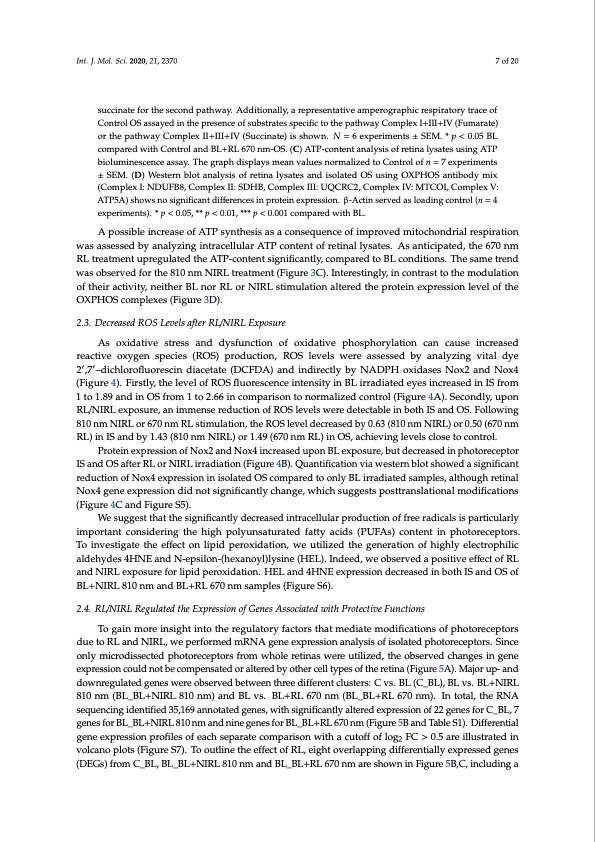
PDF Publication Title:
Text from PDF Page: 007
Int. J. Mol. Sci. 2020, 21, 2370 7 of 20 succinate for the second pathway. Additionally, a representative amperographic respiratory trace of Control OS assayed in the presence of substrates specific to the pathway Complex I+III+IV (Fumarate) or the pathway Complex II+III+IV (Succinate) is shown. N = 6 experiments ± SEM. * p < 0.05 BL compared with Control and BL+RL 670 nm-OS. (C) ATP-content analysis of retina lysates using ATP bioluminescence assay. The graph displays mean values normalized to Control of n = 7 experiments ± SEM. (D) Western blot analysis of retina lysates and isolated OS using OXPHOS antibody mix (Complex I: NDUFB8, Complex II: SDHB, Complex III: UQCRC2, Complex IV: MTCOI, Complex V: ATP5A) shows no significant differences in protein expression. β-Actin served as loading control (n = 4 experiments). * p < 0.05, ** p < 0.01, *** p < 0.001 compared with BL. A possible increase of ATP synthesis as a consequence of improved mitochondrial respiration was assessed by analyzing intracellular ATP content of retinal lysates. As anticipated, the 670 nm RL treatment upregulated the ATP-content significantly, compared to BL conditions. The same trend was observed for the 810 nm NIRL treatment (Figure 3C). Interestingly, in contrast to the modulation of their activity, neither BL nor RL or NIRL stimulation altered the protein expression level of the OXPHOS complexes (Figure 3D). 2.3. Decreased ROS Levels after RL/NIRL Exposure As oxidative stress and dysfunction of oxidative phosphorylation can cause increased reactive oxygen species (ROS) production, ROS levels were assessed by analyzing vital dye 2′,7′–dichlorofluorescin diacetate (DCFDA) and indirectly by NADPH oxidases Nox2 and Nox4 (Figure 4). Firstly, the level of ROS fluorescence intensity in BL irradiated eyes increased in IS from 1 to 1.89 and in OS from 1 to 2.66 in comparison to normalized control (Figure 4A). Secondly, upon RL/NIRL exposure, an immense reduction of ROS levels were detectable in both IS and OS. Following 810 nm NIRL or 670 nm RL stimulation, the ROS level decreased by 0.63 (810 nm NIRL) or 0.50 (670 nm RL) in IS and by 1.43 (810 nm NIRL) or 1.49 (670 nm RL) in OS, achieving levels close to control. Protein expression of Nox2 and Nox4 increased upon BL exposure, but decreased in photoreceptor IS and OS after RL or NIRL irradiation (Figure 4B). Quantification via western blot showed a significant reduction of Nox4 expression in isolated OS compared to only BL irradiated samples, although retinal Nox4 gene expression did not significantly change, which suggests posttranslational modifications (Figure 4C and Figure S5). We suggest that the significantly decreased intracellular production of free radicals is particularly important considering the high polyunsaturated fatty acids (PUFAs) content in photoreceptors. To investigate the effect on lipid peroxidation, we utilized the generation of highly electrophilic aldehydes 4HNE and N-epsilon-(hexanoyl)lysine (HEL). Indeed, we observed a positive effect of RL and NIRL exposure for lipid peroxidation. HEL and 4HNE expression decreased in both IS and OS of BL+NIRL 810 nm and BL+RL 670 nm samples (Figure S6). 2.4. RL/NIRL Regulated the Expression of Genes Associated with Protective Functions To gain more insight into the regulatory factors that mediate modifications of photoreceptors due to RL and NIRL, we performed mRNA gene expression analysis of isolated photoreceptors. Since only microdissected photoreceptors from whole retinas were utilized, the observed changes in gene expression could not be compensated or altered by other cell types of the retina (Figure 5A). Major up- and downregulated genes were observed between three different clusters: C vs. BL (C_BL), BL vs. BL+NIRL 810 nm (BL_BL+NIRL 810 nm) and BL vs. BL+RL 670 nm (BL_BL+RL 670 nm). In total, the RNA sequencing identified 35,169 annotated genes, with significantly altered expression of 22 genes for C_BL, 7 genes for BL_BL+NIRL 810 nm and nine genes for BL_BL+RL 670 nm (Figure 5B and Table S1). Differential gene expression profiles of each separate comparison with a cutoff of log2 FC > 0.5 are illustrated in volcano plots (Figure S7). To outline the effect of RL, eight overlapping differentially expressed genes (DEGs) from C_BL, BL_BL+NIRL 810 nm and BL_BL+RL 670 nm are shown in Figure 5B,C, including aPDF Image | Photobiomodulation Mediates Neuroprotection against Retinal

PDF Search Title:
Photobiomodulation Mediates Neuroprotection against RetinalOriginal File Name Searched:
ijms-21-02370.pdfDIY PDF Search: Google It | Yahoo | Bing
Cruise Ship Reviews | Luxury Resort | Jet | Yacht | and Travel Tech More Info
Cruising Review Topics and Articles More Info
Software based on Filemaker for the travel industry More Info
The Burgenstock Resort: Reviews on CruisingReview website... More Info
Resort Reviews: World Class resorts... More Info
The Riffelalp Resort: Reviews on CruisingReview website... More Info
| CONTACT TEL: 608-238-6001 Email: greg@cruisingreview.com | RSS | AMP |